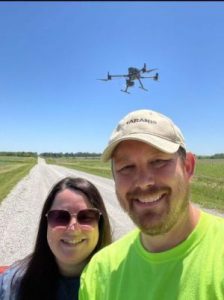
Inflationary Pressures for Good?
Greetings Hivers,
It’s been a few bumpy months for our society. But, I’m pleased to announce that DroneHive has not been thrown off course. We are beginning to understand the impact of the new 2022 economic landscape, and our most consistent pilot feedback is that the price they’re paying at the pump is killing them. We hear you — and have prompted our clients to act. Some listen, some do not.
Times of increased operational pressure force businesses large and small to review their approach, costs, prices, and underlying economics. And I’m optimistic that these times of inflationary pressure may be good, at least for the maturing UAS industry. We know about Drones for good – but what about Inflation for good? It sounds crazy but hear me out. In the short term and the longer horizon, I am confident fuel and labor pricing impacts for many businesses may expedite the broader adoption of new, greener, less energy-dependent practices, and operations. Drones present a long-term solution.
I previously mentioned that the Skyward departure had impacted us. Skyward was a perfect client for DroneHive, and I now understand why Verizon pulled the plug on their unmanned aviation division. It was a decision made at the corporate level, and given the state of the economy over two months later, it was likely a sensible one for their organization. Cutting costs and hoarding cash to weather a pending recession is probably wise and welcomed by shareholders.
Alternatively, many corporations examine the cost savings of utilizing unmanned aviation operations. A prime example lies in infrastructure inspections. When you compare the variable cost of deploying a two-person team in a diesel truck to inspect a single cell tower (in a remote area) versus the expense of a remote pilot operating a battery-powered drone (and hopefully driving a hybrid vehicle), the financial benefits are clear. Executives are highly interested in how they can improve efficiency at any level in these challenging times. I’m sure drones are getting more attention from decision-makers.
My last comment addresses how DroneHive’s day-to-day operations have changed: we prioritize pilots based near new job offerings. We are also prioritizing pilots with fuel-efficient vehicles. Not only for the sake of the environment but because we cannot offer mileage reimbursement, we contracted back at the beginning of the year. In all new contract engagements, we will strongly consider current fuel costs and the rising labor rate demand in our pricing efforts, but it’s not enough. Our clients have also been receptive as they feel this new reality in their wallets at the pump.
Better days are ahead! Summer 2022 is the busiest we’ve ever seen, and I see that trend continuing into 2023 and beyond.
Cheers from your Founder,
Paul Huish
Chief Executive Office
Accident Reporting – When is it required?
Hello DroneHive Pilot Community:
I hope that you are all doing well! The summer season is here, and the demand at DroneHive is solid. Let’s keep safety our top priority as we tackle the summer season.
As promised, I am continuing my dive into the Part 107 Advisory Circular (AC) 107-2A. You can find a copy here. I want to review accident reporting requirements from Chapter 4 under Subpart A, General, Section 4.4. We’ve recently had a few incident/anomaly reports (non-accidents) come in; this is an excellent time to review accident reporting procedures. You can also reference accident reporting under FAR 107.9. I recommend reviewing this AC periodically as part of your ongoing professional pilot development.
According to the AC, the remote PIC is required to report an accident to the FAA within 10 days if the situation meets the following criteria:
- 1. At least serious injury to any person or any loss of consciousness; or
- 2. Damage to any property, other than the small unmanned aircraft:
- If the cost is greater than $500 to repair or replace the property (materials and labor; or
- The property’s fair market value does not exceed $500 in the event of a total loss.
If your situation meets the above criteria, you can submit a report online through your FAA DroneZone account:

Lastly, each DroneHive RPIC must complete a post-flight operation report after every flight (this is how you get paid!). This report also has a tab for accident/incident reporting. This portion should be filled out anytime an accident meets the criteria above, or you encounter any incident/mishap/anomaly while on site. DroneHive collects and reviews this data as part of our Safety Management System.
If you missed the DronHive Training Webinar on May 26, you can watch the replay posted here. I gave practical advice for securing an ATC Authorization. Stay tuned for our next Webinar and registration details!
Our Flight Operations team is here to help you! Please do not hesitate to contact us if you need assistance with CoAs, flight planning, or general questions.
Safe flying,
Michael Walcker
Safety Officer DroneHive, Inc.
Partner Spotlight
![]()
Building a world where drones are used for good.
About Enterprise UAS: As the parent company of leading drone dealers DSLRPros, Dronefly and Aerial Media Pros, Enterprise UAS is one of the top distributors for commercial drones and related equipment in North America, specializing in custom aerial solutions for professionals in the public safety, industrial inspection, construction, and agriculture industries.
Special offer for DroneHive pilots:
We want to prove ourselves to be your trusted hardware partner that supports you as you grow your drone services business into the future. Email us at [email protected] or call 213-262-9436 and as a Drone Hive pilot you will receive a coupon code good for 5% off applicable drone products! We also have a capable repairs department to get your old crafts back in the air, and a support team who can help you work with technical issues so don’t hesitate to reach out.
When to Use NTRIP for Survey Grade Accuracy
Greetings, fellow RPICs,
Regarding delivering survey-grade, or centimeter-level accuracy, for mapping flights, there are primarily two techniques, RTK and PPK. Real-Time Kinematic (RTK) is a GPS correction technology that provides real-time location data corrections as the drone is surveying and capturing images from a site. Post Processed Kinematic (PPK) is a GPS correction technology technique that corrects location data after it is collected and uploaded. It is often implemented by placing ground control points (GCPs), which is labor-intensive in the field.
This is where the benefits of using NTRIP may come into play, especially for recurring missions. NTRIP (Networked Transport of RTCM via Internet Protocol) is a protocol used for streaming corrections in real-time (RTK) over the Internet from a base station to a rover (on the drone) to achieve cm-level accuracy. The base station needed can either be co-located on-site or remote and connected via the internet within a 10.5km range to the drone (hosting the rover). The main benefit of having your own base station on site is that if you do not have access to internet connectivity, either from your cellular network or from site-provided Wi-Fi access to the internet, you can still perform RTK. However, many pilots are reluctant to invest in a base station due to its high cost. The alternative RTK implementation is to use NTRIP from a commercial provider, through their network of base stations, as a subscription service. The advantage is not needing your own base station and avoiding setup and teardown time for each site visit. Depending on the base station model, this can be very labor-intensive. A dwelling time on the order of hours may be needed to acquire and integrate enough sampling data to lock into usable RTK GPS corrections. With NTRIP, in concept, you are effectively using a remote
base station “tethered” over the internet, therefore would require reliable connectivity to be able to use NTRIP.
The ideal conditions for using NTRIP, based on my observation and interactions with our fellow RPICs, are summarized here, though this may not be an exhaustive list but is sufficient as general guidance:
- An airframe supporting NTRIP with entering a subscriber account, password, and mounting point (location of the provider’s closest base station).
- On-site RELIABLE (vs. spotty) internet connectivity via a cellular provider or Wi-Fi access.
- Baseline distance of 10.5km or less between (rover on) airframe and the remote station.
- Minimal horizon clearance, typically 15-20° above the horizon, optimizing GPS sky coverage.
- A clear line of sight between controller and drone THROUGHOUT the entirety of the flight mission.
- NTRIP provider, either commercially (typically $1,000/year) or publicly sponsored at the state level, hosted by the state’s dept of transportation, which is FREE in some states.
Happy Flying!
Peter Ning
Flight Operations Director
Pilot Spotlight

Sean Sebourn
Sean and his wife Miranda began their video business “Sebourn Video Services” in 2008. 8 years later, after watching a Travel TV Show and seeing drone footage within the show, Sean decided to study for his Part 107 and then purchased a DJI Phantom 4. Sean’s business began to explode with opportunities with this new feature of aerial photos and video. From weddings to real estate, new construction, homesteads, disaster documentation, cellular tower 3D graphing, and even helping the local law enforcement with searches, demand for Sean’s drone services rapidly increased. Sean added a DJI Mavic 2 Pro in 2019 to provide better quality cinematography. In 2022, Sean joined the DroneHive Pilot Network and began work with their client flying a DJI Matrice 300. To date, Sean has flown over 400 flights totaling over 100 hours above Iowa’s agriculture which covers about 20,000 acres.
| What’s Up With Drones & GA July 25 – 31, 2022 OshKosh, WI |

|
| InfoAg Conference and Trade Show July 26 – 27, 2022 St Louis, MO |

|
| Vertical Focus. Global Outreach September 6 – 8, 2022 Las Vegas, NV |

|
